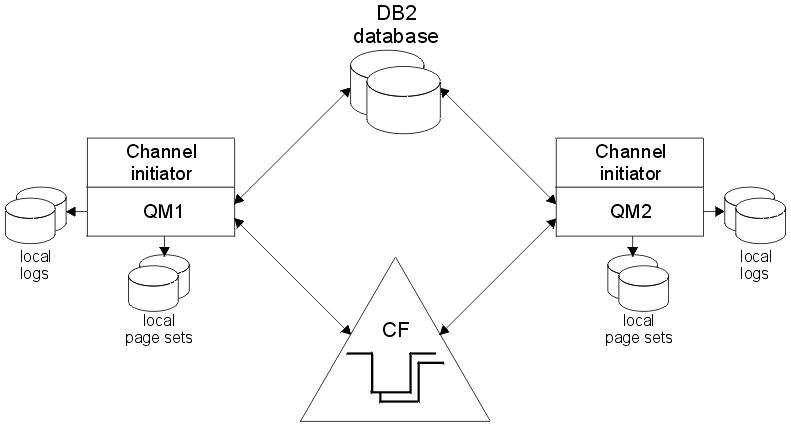What is a queue-sharing group?
The group of queue managers that can access the same shared queues is called a queue-sharing group. Each member of the queue-sharing group has access to the same set of shared queues.
Queue-sharing groups have a name of up to four characters. The name must be unique in your network, and must be different from any queue manager names.
In the illustration below, each queue manager has a channel initiator and its own local page sets and log data sets.
Each member of the queue-sharing group must also connect to a DB2 system. The DB2 systems must all be in the same DB2 data-sharing group so that the queue managers can access the DB2 shared repository used to hold shared object definitions. These are definitions of any type of WebSphere MQ object (for example, queues and channels) that are defined only once and then any queue manager in the group can use them. These are called global definitions
More than one queue-sharing group can reference a particular data-sharing group. You specify the name of the DB2 subsystem and which data-sharing group a queue manager uses in the WebSphere MQ system parameters at startup.

When a queue manager has joined a queue-sharing group, it has access to the shared objects defined for that group, and we can use that queue manager to define new shared objects within the group. If shared queues are defined within the group, we can use this queue manager to put messages to and get messages from those shared queues. Any queue manager in the group can retrieve the messages held on a shared queue.
We can enter an MQSC command once, and have it executed on all queue managers within the queue-sharing group as if it had been entered at each queue manager individually. The command scope attribute is used for this.
When a queue manager runs as a member of a queue-sharing group it must be possible to distinguish between WebSphere MQ objects defined privately to that queue manager and WebSphere MQ objects defined globally that are available to all queue managers in the queue-sharing group. The queue-sharing group disposition attribute is used for this.
We can define a single set of security profiles that control access to WebSphere MQ objects anywhere within the group. This means that the number of profiles you have to define is greatly reduced.
A queue manager can belong to only one queue-sharing group, and all queue managers in the group must be in the same sysplex. You specify which queue-sharing group the queue manager belongs to in the system parameters at startup.